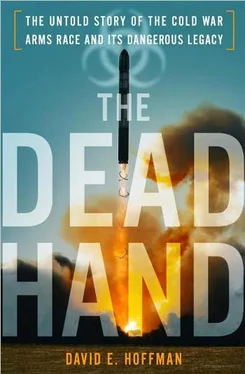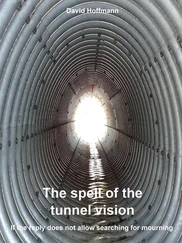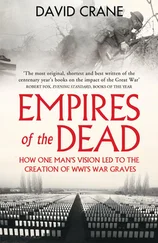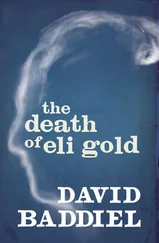The satellite system was known as Oko, or “Eye,” but the individual spacecraft were known to Petrov by simple numbers, one through nine. On this night, No. 5 was reaching the highest point of its orbit, about 19,883 miles above the Earth. From space, it scanned the very edge of the Earth, using infrared sensors to detect a missile launch. The satellite could spot the heat given off by a rocket engine against the black background of space, a delicate trick requiring the satellite to be in the right position, steady and aimed at the distant point where the Earth met the darkness of the cosmos. Of the whole fleet, No. 5 had the highest sensitivity, but its task was complicated by the time of day. The satellite was aimed at missile fields that were passing from daylight to twilight during Petrov’s shift. Dusk was often a blurry, milky zone that confused the satellites and computers. The operators knew of the challenge, and watched closely.
Usually, each satellite picked up fifteen or twenty objects of interest, and the computers at Serpukhov-15 examined the data on each, checking against the known characteristics of a rocket flare. If it did not look like a missile, the objects would be discarded by the computer and a new target grabbed for examination. The computer ran continuous checks against the data streaming in from space. The satellites also carried an optical telescope, with a view of the Earth. This was a backup, allowing the ground controllers to visually spot a missile attack, but the images were dim—in fact, special operators had to sit in a darkened room for two hours so they could see through the telescopes.
On this night, satellite No. 5 was bringing in more data than usual. Instead of fifteen to twenty targets, it was feeding the computer more than thirty. Petrov figured the elevated levels were due to the satellite’s heightened sensitivity. They watched it closely as it approached the apogee of its orbit, when it would be positioned to monitor the American missile fields. At 10 P.M., Petrov paused for tea.
Petrov and his men had watched many test launches from Vandenberg Air Force Base in California and from Cape Canaveral in Florida, as well as Soviet test launches from Plesetsk in northern Russia. With the satellites, they could rapidly detect the rocket’s bright flare moments after it rose into the sky; they had seen a few tests fail, too.
For all the years Petrov worked at the early-warning center, they had been rushed. The satellite system was put into service in late 1982, even though it was not ready. Petrov and his men were told: it was an important project for the country, don’t worry about the shortcomings. They will be fixed later, you can compensate for the problems, look the other way for now. Petrov knew why they were in such a hurry. The United States and the Soviet Union threatened each other with missiles on hair-trigger alert. The two superpowers had between them about 18,400 nuclear warheads poised to be launched from missiles in silos, on submarines hidden under the seas and from bombers. And there were many smaller, or tactical, nuclear weapons arrayed along the front lines of the Cold War confrontation in Europe. In the event of a nuclear attack, a decision whether to retaliate would have to be made in minutes, and enormous efforts were made by each superpower to gain precious time for warning. With ground-based radar alone, which could not see beyond the curvature of the Earth, the incoming missiles might not be detected until the final seven to ten minutes of their flight. But with the early-warning satellites, a launch could be spotted sooner. The Americans already had stationed their satellites to watch over the Soviet missile fields. The Soviet Union was in a hurry to catch up. They rushed to build Serpukhov-15 and launch their own satellites.
A fear haunted the old men who ruled the Soviet Union, led by General Secretary Yuri Andropov, a frail and paranoid former KGB chief who in the autumn of 1983 was suffering from kidney failure. The fear was a sudden attack that might destroy the entire leadership in Moscow before they could leave the Kremlin. If they could be decapitated, wiped out without warning by a surprise attack, their threat to retaliate was simply not credible. That is why Petrov’s mission was so important. The satellites, the antennas, the computers, the telescopes, the map and the operations center—they were the night watch for nuclear war.
Petrov heard the rhetoric, but he didn’t believe the superpowers would come to blows; the consequences were just too devastating. Petrov thought the Soviet leaders were pompous and self-serving, and—in private—he was disdainful of the party bosses. He did not take seriously their bombast about America as the enemy. Yet the furor in recent months had been hard to ignore. President Ronald Reagan had called the Soviet Union an “evil empire” in March, and only a few weeks before Petrov’s night at the operations center, Soviet Air Defense Forces had shot down a Korean airliner in the Far East, killing 269 people.
Petrov saw himself as a professional, a technician, and took pride in overcoming long odds. He understood the enormity of the task, that in early warning there could be no room for false alarms. His team had been driven hard to eliminate the chance for error. While they had tried strenuously to make the early-warning system work properly, the apparatus was still troubled. A system to make decisions about the fate of the Earth was plagued by malfunctions. Of the first thirteen satellites launched in the test phase from 1972 to 1979, only seven worked for more than one hundred days. 12The satellites had to be launched constantly in order to keep enough of them aloft to monitor the American missile fields. They often just stopped sending data back to Earth.
At 12:15 A.M., Petrov was startled. Across the top of the room was a thin, silent panel. Most of the time no one even noticed it. But suddenly it lit up, in red letters: LAUNCH.
A siren wailed. On the big map with the North Pole, a light at one of the American missile bases was illuminated. Everyone was riveted to the map. The electronic panels showed a missile launch. The board said “high reliability.” This had never happened before. The operators at the consoles on the main floor jumped up, out of their chairs. They turned and looked up at Petrov, behind the glass. He was the commander on duty. He stood, too, so they could see him. He started to give orders. He wasn’t sure what was happening. He ordered them to sit down and start checking the system. He had to know whether this was real, or a glitch. The full check would take ten minutes, but if this was a real missile attack, they could not wait ten minutes to find out. Was the satellite holding steady? Was the computer functioning properly?
As they scrambled, Petrov scrutinized the monitors in front of him. They included data from the optical telescope. If there was a missile, sooner or later they would see it through the telescope. Where was it headed? What trajectory? There was no sign of it. The specialists who sat in the darkened room, also watching the telescope, spotted nothing. The computer specialists had to check a set of numbers spewing out of the hard-copy printer. Petrov scrutinized the data on his monitor, too. Could it be a technical error?
If not, Petrov ran through the possibilities. If just one missile, could it be an accidental or unauthorized launch? He concluded it was not likely. He knew of all the locks and precautions—and just one person could not launch a missile. Even the idea of two officers conspiring to launch a missile seemed impossible. And if one missile was launched, he thought, what did that mean? This was not the way to start a nuclear war. For many years, he had been trained that a nuclear war would start only with a massive strike. He said it again, to himself: this is not the way to start a nuclear war.
Читать дальше












